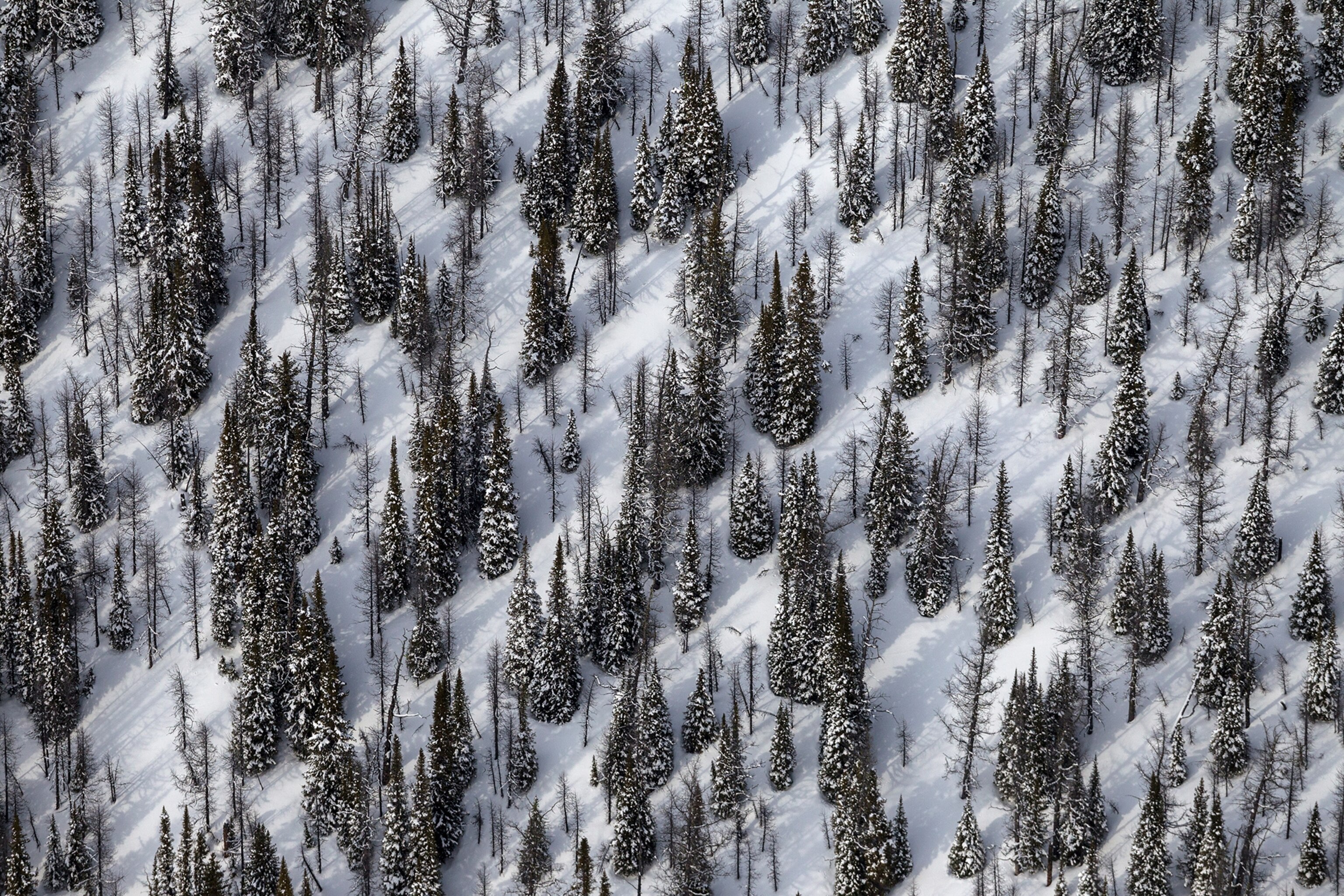That unmistakable evergreen smell. Fallen needles littering presents below. Freshly chopped Christmas trees invoke fond memories of Christmases past.
Yet artificial trees have also been part of the holiday for centuries, evolving from tiny trees made of metal to the shockingly realistic plastic trees we have today.
In fact, recent decades have seen a steady shift to artificial trees. The United Kingdom has seen the largest shift, with 61 percent of adults planning to put up an artificial tree versus just 20 percent choosing a real one. And according to a 2024 survey by Statista Consumer Insights, more Americans will celebrate with an artificial tree, by a count of 46 percent to 26 percent.
But why did we turn to artificial trees in the first place—and how do they stack up against real evergreens when it comes to sustainability and even your health? We delved into your big questions about fake trees.

An aerial view of a snowy evergreen forest in the Goodsir Mountains in British Columbia, Canada. Artificial Christmas trees got their start in the late 19th century in response to concerns over deforestation.
Photograph By Peter Essick, Nat Geo Image Collection
Why do we celebrate with artificial trees?
Just like real Christmas trees, artificial trees were born in Germany. But these were born out of necessity. “Natural trees presented problems and inventors sought ways to solve those problems, to make something better, and to make a profit doing it,” says Chris Cascio, a curator at the Hagley Museum and Library.
(These are the real origins of Christmas trees.)
One such problem was deforestation, which had led to a dearth of real Christmas trees in the 19th century. To keep their holidays merry and bright, Germans created their own trees by arranging metal rods as branches and adorning them with bird feathers—all painted green of course. That early prototype of an artificial Christmas tree soon spread to Victorian England, the United States, and other nations celebrating the Yule.
People around the world were also starting to worry about the danger of house fires sparked by dried branches. By 1899 the Minneapolis Times pleaded “Now is the time for some inventor to step to the front with a wire Christmas tree warranted to bear a gift for every member of the family and to be absolutely fire proof.”
Actually, inventors were already on the case. The first U.S. patent for an artificial tree was granted to August Wengenroth of Troy, New York, in 1882, and he was only one of many tinkerers around the world.
Early inventors created fake trees out of all kinds of materials: wood or metal trunks that could hold real cut branches or artificial touches like green foil “foliage,” trees made from repurposed hair or wire toilet bowl brushes, and “tinsel trees” made from aluminum that could even be lit by a color wheel that changed hues as it rotated.
(How the U.S. chooses its best and brightest Christmas trees.)
But as the 1960s waned and aluminum was on the outs there was a growing interest in realistic trees and one man was ready to meet the moment: former WWII bomber pilot Si Spiegel. Spiegel was a machinist at The American Brush Machine Company, which had tried unsuccessfully for years to repurpose its brushes for Christmas trees—until Spiegel, using real trees as models, finally nailed the process.
Spiegel was given his own division of the company, named American Tree and Wreath, and by the 1970s it was producing 800,000 trees a year—one every four minutes. “It’s not just that he engineered the machinery to make a higher quality tree, quickly, and at less expense,” Cascio explains. “He did it at the right time—just when Americans were ready.”
Which is more sustainable—real trees or fake trees?
You might have heard people making claims about which type of tree is actually greener—real or fake trees. Some argue that you need to compare the carbon footprint of real trees against artificial trees that can be used and reused for decades.
But experts say carbon is only part of this Christmas story.
You May Also Like
“There are an estimated 15,000 Christmas tree farms in the U.S., nearly all of which are family-owned and operated,” says Bert Cregg, an expert in Christmas tree production and forestry at Michigan State University.

A young woman sits next to her aluminum tree on Christmas Day in the 1970s. Early versions of artificial Christmas trees tended to be these diminutive tabletop varieties.
Photograph By Martyn Evans / Alamy
Each year those farms plant many more new trees than the 25 to 30 million sold at Christmas—so rather than contributing to deforestation as they did in the 19th century, natural trees are growing forests that host wildlife, protect watersheds, keep land out of development, and act as significant natural carbon dioxide absorbers. For these reasons, Cregg says, environmental, economic, and social sustainability produce “a slam dunk for real trees.”
Meanwhile, artificial trees are made from plastics and metal and require energy-hogging production processes. What’s more, the majority are produced in China and then shipped overseas.
(Here’s what to know about the world’s plastic pollution crisis.)
They do have far longer lifespans than single-season natural trees. But it’s not clear exactly how long you might have to keep an artificial tree to come out ahead on its carbon footprint versus the natural alternative: estimates range dramatically from five years to two decades.
“It often gets down to what assumptions are made regarding how many times the fake tree is re-used and whether the real tree is recycled,” Cregg says. Most communities have programs that turn real trees into mulch or compost. Meanwhile, artificial trees are not recyclable and will eventually end up in a landfill—although Mac Harmon, CEO of artificial tree purveyors Balsam Hill, says he hopes to find a way to recycle artificial trees in the future.

Can you tell which of these branches comes from a real Christmas tree—and which one is artificial? (Hint: The needles on a real tree have round points.)
Photograph By Rebecca Hale, National Geographic
Should you worry about chemicals in your tree?
Scientists continue to discover more about how pesticides, chemicals, and microplastics harm your health—but does that also apply to the trees you bring inside every winter?
There’s no good answer yet for either real or artificial trees. But there are a few things that we do know.
During their years of growth, natural Christmas trees are treated with various herbicides, pesticides, or fungicides that are linked to various health and environmental harms. Although there’s still much unknown about their potential health impacts, the World Health Organization has labeled some of these insecticides as probable carcinogens. You might consider getting an organic tree if you’re concerned about the potential impacts of these agricultural chemicals.
(This is what you need to know about lead and your health.)
Meanwhile, artificial Christmas trees are often made with polyvinyl chloride (PVC), a plastic that contains a group of endocrine disrupting chemicals called phthalates that are used to soften artificial greenery and produce that realistic feel. The EPA has warned that high exposure to phthalates may be linked to health problems including reproductive health and child development issues, and the Consumer Product Safety Commission has banned many phthalates from children’s toys. But it’s unclear how much risk you run simply by displaying a phthalate-laden Christmas tree for a few weeks each year—and U.S. regulators have so far not imposed any restrictions.
Similarly some plastic trees also contain toxic lead—however research shows that lead exposure is not typically a major health concern with modern artificial trees.
But don’t let worries ruin your holiday cheer. When it comes down to which tree you should choose, Harmon argues there aren’t really any bad choices. “We love all kinds of Christmas trees,” he says. “The Christmas tree that’s best is the one you celebrate around with friends and family.”











